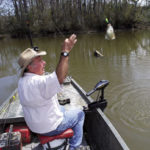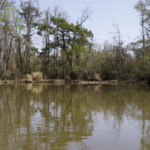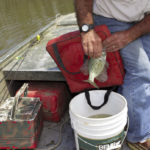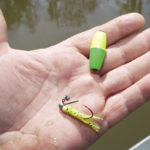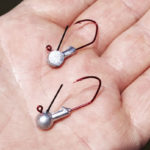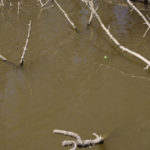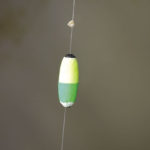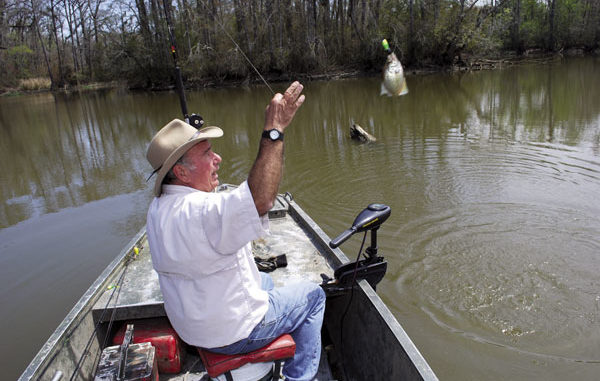
Retired LDWF biologist Tommy Prickett is making the most of his retirement, particularly this time of year, when the Tchefuncte River sac-a-lait are biting like mad.
On May 31, 2004, Thomas Edward Prickett retired from the prestigious job of Chief of the Wildlife Division of the Louisiana Department of Wildlife and Fisheries. In his 33 years with the department, he worked on the brown pelican restoration project, the shrimp mariculture project at the Grand Terre Lab, served as Quail Study Leader and then as Chief of the Fur and Refuge Division before heading up the Wildlife Division.
He planned to hunt and fish nearly every day of the week. He was on top of the world.
Then, on Dec. 6, 2008, at the St. Tammany Parish Hospital, Tommy Prickett died.
“The first thing that hit the floor of the hospital was my nose,” he twanged in the north Alabama accent that he has never completely left behind. “I was lucky to be in the emergency room, and I was lucky that a cardiologist just happened to be walking by with a shocking cart [defibrillator] when I fell on my face.
“They brought me back to life. If I hadn’t been there and he hadn’t been right there, I wouldn’t be here today. I woke up two days later with a broken nose, two black eyes and a stent in my left descending anterior coronary artery, the one they call ‘the widow maker.’ People get one attack there, and they die.”
Prickett had gone to the hospital on two consecutive days with what he thought was spinal stenosis. The second day is when the big one hit. Medical experts say that there is only a five-minute window of life after the widow maker occludes.
He got out of the hospital, chopped wood the next day and then went to his duck camp. He has been hunting and fishing three to four days a week since.
The water in the canal behind his beautiful house in the Flowers Estates Subdivision was low — really low.
“I never have seen it this low since the 1960s,” he half-grunted as he used the long tail of his mud motor to torque the boat around on what was as much mud flat as water.
“We’ll see if they bite today with the water this low,” he said. “Good thing about living right here is that if they aren’t biting, I just go to the house, do something else and come back later.”
We were planning to pursue crappie (white perch, as he calls them) in the Tchefuncte River system.
After Prickett got the boat turned around, he putt-putted leisurely through the tall pines and hardwoods that line both sides of Flowers Bayou. The hardwood trees were still mostly bare, although a few trees showed glimpses of their coming vibrant spring green colors. Some red maple seeds still clung to their stems, adding a bit of color.
Sun beams from the bright blue sky splattered through the trees and played over Prickett, highlighting his cornflower blue eyes and ruddy complexion. He looked the picture of health and happiness.
Flowers Bayou runs out into Horseshoe Bayou, an old oxbow of the Little Tchefuncte River. The Little Tchefuncte and the Bogue Falaya River meet immediately north of Interstate 12 to form the Tchefuncte River. Prickett planned to fish all the way to the interstate, concentrating on old sloughs and other waters away from the main channel of the rivers. Less boat traffic means better fishing, he explained.
His first stop was shortly after entering Horseshoe Bayou.
“In 40 years I’ve caught enough bass and white perch here to sink a battleship,” he said. “I’ve already caught 400 or 500 this year. They usually don’t start until later, but this year they started in mid February.
“I catch 25 and go home — bring them to the house and eat them or give them to friends. I don’t freeze fish. I like them broiled, and we fry them too.”
Prickett unlimbered his 10-foot fiberglass jig pole. The external reel beneath the handle allowed him to use his free hand to grab the line immediately ahead of the reel to pull the jig close to the rod tip. After he poked the rod into the spot he wanted with the other hand, he dropped the line, letting the bait fall into the thick brush that the fish seemed to prefer.
“I started using a jig pole this year,” he explained. “I used to use a rod and reel and Beetle Spin with a grub or a tube jig on the hook.”
Prickett is a big believer in using a sliding cork above his jig head to control its fishing depth. When trying to fish 4-feet deep, the jig head and fixed cork spin end over end when he tries to flip his hook into tight spots. He has tied a piece of a rubber band on the line as a stopper instead of the string that comes with the cork. He said that he loses the strings easily, and a rubber band doesn’t slip as easily as a string.
Prickett used a trolling motor slung over the right side of the boat to poke it along the bank slowly, while he probed every bit of cover with his jig with surgical precison. He picked up one white perch, then another. The bite wasn’t fast, but some fish were feeding.
Horseshoe Bayou was picturesque. A few cypress trees fringed the water, and shiny-leafed evergreen magnolia trees were scattered among the other trees in the woods.
The low tide had exposed logs and tree tops everywhere. The fish have plenty of cover at normal tide. The Tchefuncte River’s water levels are dictated by Lake Pontchartrain, into which it empties. A big blow from the north will push water out of the lake and lower the water levels in the river.
Most of the white perch Prickett caught were fairly deep, 2 feet or more, probably due to the cold front that just blew through.
“A slip cork is nice when they’re on the bank,” he said. “I’ve been catching them in 14 inches of water, but you have to experiment.”
Effective as it was, this was low-tech fishing. The trolling motor was of the hand-control clamp-on variety. He sat on a 5-gallon bucket half full of water. That was where the fish he caught went, not in an aerated live-well or an ice chest. A boat cushion on top of the bucket kept him from getting “bucket-butt.”
Of course, he didn’t have to sit on the bucket long. Every few minutes he was dropping another fish in it.
“March and April,” he volunteered as he stood up to add another fish. “Three or four days in front and back of the full moon — that’s when the big females come in to spawn. You catch the males on the nest then. When the females pull off the bank, they’re hard to locate.
“The very best time to fish for white perch here is the day before the rain ahead of a front. The very worst conditions are bluebird skies right after a front.”
Like now.
Only one other boat passed us all morning, hard to believe even for a weekday. Public boat launches aren’t that far away. One is located at the end of Janke Avenue in Covington and another one is near the mouth of the Tchefuncte River.
While Prickett fished, he provided a primer on his terminal tackle, something about which he is particular.
“I like a 1/8-ounce jig head best, but it will sink the little cork that I like to use,” he said. “I like enough weight to make my cork bounce when it hits the stopper. It makes the jig flutter a little bit rather than just stop. That motion attracts fish.
“You don’t get that with a 1/16-ounce head. So I take my 1/8-ounce heads and grind part of the lead off each side of the head — just enough so that my cork barely floats.”
All his jig heads are weedless. He maintains that they cut his hang-ups in brush by 80 percent. He can only find the style he likes at one place, Bass Pro Shops, and so he stocks up when he stops there.
Prickett ties his jig head directly to the line. Snap swivels, he believes, affect the action of the jig.
He uses both tube jigs and beetle grubs. Preferred colors are blue/white and salt-and-pepper/chartreuse for tubes and either black or yellow for grubs.
“If they’re biting, they’ll usually bite one of these,” he said. “It is more important to put it where the fish are than change colors. I am not a big bait changer.”
A jig pole lets you fish where the fish are.
He dropped the bait and cork gently in the water so that it didn’t make a fish-alarming splash. Then he twitched it gently for a few seconds before picking it up and dropping it in another spot.
Prickett believes that white perch in shallow water are spooky. He prefers off-colored, but not muddy, water over greenish clear water. He thinks that in clearer water, white perch will come off the bank as the sun comes up.
He moved a lot as he fished.
“Normally, when they’re on the bank, you don’t catch four or five in one spot,” he said. “They’re kind of scattered.”
He poked his rod into every brushtop, but didn’t completely ignore entirely open areas, especially if they were close to vertical banks near deep spots.
He even jigged in the middle of the bayou once in a while and caught a few fish. Occasionally, he picked up an ultra-light spinning rod and made a few casts with a Beetle Spin.
“You catch a bigger average-size white perch on a spinner than on a jig,” he said.
Even on his spinning rod, he used his favorite weedless jig.
“You hang up every 20th cast instead of every cast,” he added with a puckish grin.
Well before noon, he had fished his way to within good earshot of the vehicular traffic on I-12, his terminal destination. His bucket wasn’t full, but he had a good mess — not bad for the day after a front.
Back at home, Prickett quickly cleaned his catch and then pulled up a lawn chair. He talked about his annual schedule in retirement. January into April finds him fishing for white perch. When turkey season begins, he hunts turkeys and usually takes his two-bird annual limit in Louisiana before Easter.
He frequently hunts right next to his home, near other houses in subdivisions, where hunting is legal but the turkeys aren’t hunted a lot.
“I call them ‘virgin turkeys,’” he said with a guilty grin.
In six years he has made 13 hunts and taken 12 turkeys.
Then he heads for other states that have later seasons to hunt turkeys, including Texas, Mississippi, Alabama and Oklahoma.
After turkey season, sometime in May, he begins to transition to his camp in Boothville to fish for trout, redfish and bass out of Venice, especially when Mississippi River water levels drop.
He interrupts his fishing in the first week of August to bow hunt in Colorado for elk and if he is lucky enough to draw a tag, mule deer.
“I started hunting for elk,” he said, “because every piece of an elk is good. And compared to whitetail deer, they are pretty stupid — easy to slip up on. If I have meat on the table, nine times out of 10 it is fish or game.”
Then it’s back to Venice until September and dove season.
“I love dove hunting,” he said. “I would hunt every day if I had a place to go. I make four or five hunts a year. Then I hunt teal.”
October finds him still haunting his camp in Boothville and fishing in Venice, although he does piddle around his deer food plots some. He readily admitted that he doesn’t hunt whitetail deer much, preferring to bird hunt.
From November into January, duck hunting in Venice absorbs his time. The biologist in him came out when he talked about duck hunting.
“We average 4.8 birds per hunter effort,” he said. “We were off a little last year with 4.4 to 4.5 per hunter effort. Gadwall and wigeon are our bread and butter.
“We kill our one drake pintail every hunt. Mix that in with a few teal and your one canvasback.”
He makes a couple of squirrel hunts with a rifle every fall, something that he said he really enjoys. He admitted that he still has a passion for quail and woodcock hunting, but only makes a quail hunt or two a year in Texas or Georgia.
If that isn’t enough, he and his wife and daughters go to Florida to snorkel for lobster every August.
“It’s like Mardi Gras when that season opens,” he said. “Boats are everywhere.”
Prickett sat quietly for a few minutes, then leveled his gaze, grinned and said with conviction, “I like retirement. I found something that I’m good at.
